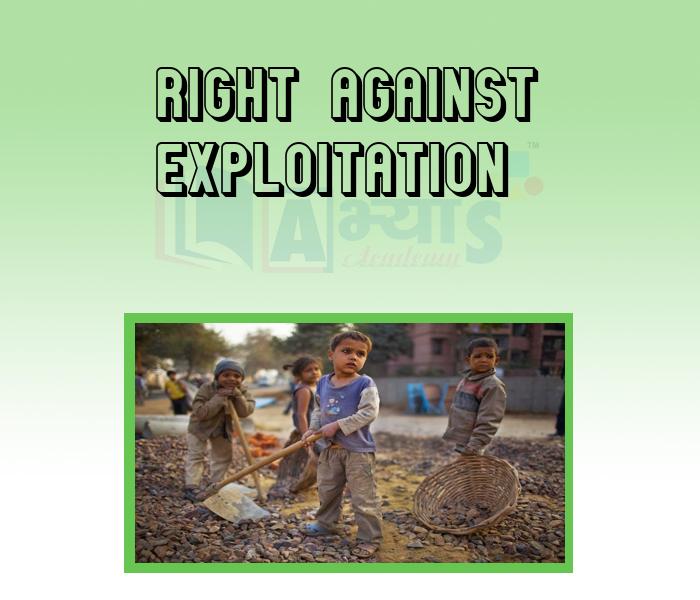Right Against Exploitation











Right Against Exploitation
Right Against Exploitation (Art 23-24), prohibiting all forms of forced labour, child labour and traffic in human beings.
The right against exploitation, given in Articles 23 and 24, provides for two provisions, namely the abolition of trafficking in human beings and begar (forced labour), and abolition of employment of children below the age of 14 years in dangerous jobs like factories and mines. Child labour is considered a gross violation of the spirit and provisions of the Constitution. Begar, practised in the past by landlords, has been declared a crime and is punishable by law. Trafficking in humans, for the purpose of slave trade or prostitution, is also prohibited by law. An exception is made in employment without payment for compulsory services for public purposes. Compulsory military conscription is covered by this provision.
Article 23 provides rights against human misconduct, forced labour and bonded labour.
Article 23(1) : Traffic in human beings and the beggar and other similar forms of forced labour are prohibited and any contravention of this provision shall be an offence punishable in accordance with the law.
Which of the following are correct : (a) Trafficking in humans, for the purpose of slave trade or prostitution is prohibited by law. (b) An exception is made in employment without payment for compulsory services for public purposes. | |||
| Right Option : C | |||
| View Explanation | |||
Which of the following are correct : (a) Article 23 of the Indian Constitution provides rights against human misconduct, forced labour and bonded labour. (b) Article 24 of the Indian Constitution prohibits the employment of children below the age of 14 years in hazardous works like factories, etc. (c) Article 25 of the Indian Constitution provides rights against human misconduct, forced labour and bonded labour. | |||
| Right Option : A | |||
| View Explanation | |||
Use of Child Labour is prohibited in hazardous industries by _____________________________- | |||
| Right Option : D | |||
| View Explanation | |||
Students / Parents Reviews [10]
I have spent a wonderful time in Abhyas academy. It has made my reasoning more apt, English more stronger and Maths an interesting subject for me. It has given me a habbit of self studying

Yatharthi Sharma
10thAbout Abhyas metholodology the teachers are very nice and hardworking toward students.The Centre Head Mrs Anu Sethi is also a brilliant teacher.Abhyas has taught me how to overcome problems and has always taken my doubts and suppoeted me.

Shreya Shrivastava
8thIt has a great methodology. Students here can get analysis to their test quickly.We can learn easily through PPTs and the testing methods are good. We know that where we have to practice

Barkha Arora
10thMy experience was very good with Abhyas academy. I am studying here from 6th class and I am satisfied by its results in my life. I improved a lot here ahead of school syllabus.

Ayan Ghosh
8thIt was good as the experience because as we had come here we had been improved in a such envirnment created here.Extra is taught which is beneficial for future.

Eshan Arora
8thAbhyas is a complete education Institute. Here extreme care is taken by teacher with the help of regular exam. Extra classes also conducted by the institute, if the student is weak.

Om Umang
10thBeing a parent, I saw my daughter improvement in her studies by seeing a good result in all day to day compititive exam TMO, NSO, IEO etc and as well as studies. I have got a fruitful result from my daughter.

Prisha Gupta
8thIt was a good experience with Abhyas Academy. I even faced problems in starting but slowly and steadily overcomed. Especially reasoning classes helped me a lot.

Cheshta
10thAbhyas Methodology is very good. It is based on according to student and each child manages accordingly to its properly. Methodology has improved the abilities of students to shine them in future.

Manish Kumar
10thMy experience with Abhyas is very good. I have learnt many things here like vedic maths and reasoning also. Teachers here first take our doubts and then there are assignments to verify our weak points.
